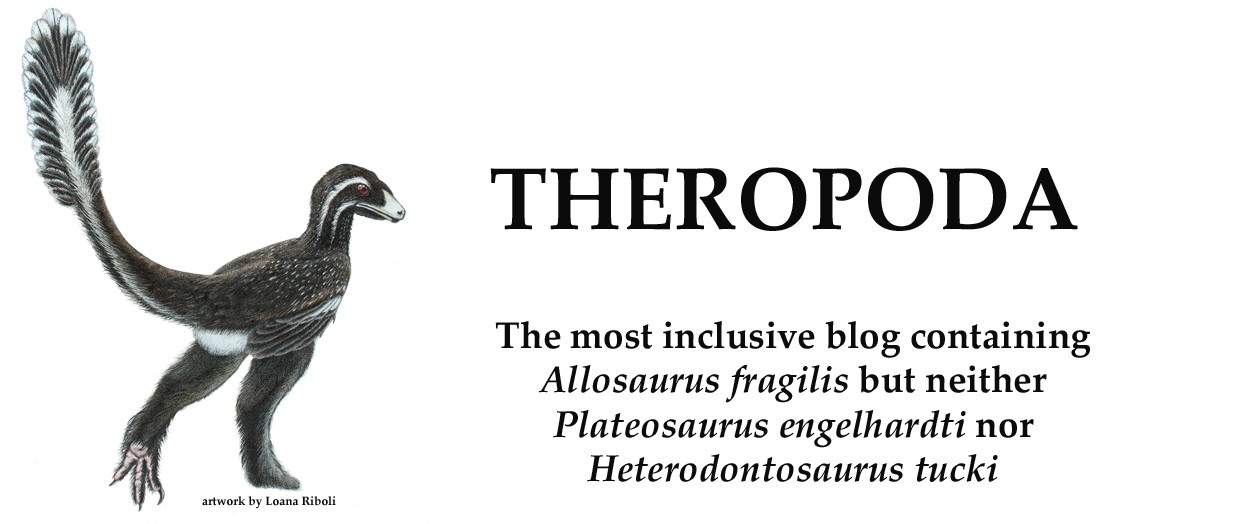Vi ricordate l'ipotesi "superornithica" di Paul (1988) che ipotizza uno status aviano per Oviraptorosauri e Deinonychosauri, entrambi ritenuti più prossimi agli uccelli moderni rispetto a Archaeopteryx? Ricordate il cosiddetto "avialan status" per gli oviraptorosauri ipotizzato da Maryanska et al. (2002)? Vi ricordate la mia suggestione "Magnoviraptorosauriana", almeno nella versione debole, che accomuna Scansoriopterygidae e Oviraptorosauria? Una nuova versione di queste ipotesi "non-standard" per Maniraptora, con i vari "non-avian" classici (Deinonychosauri e Oviraptorosauri) collocati all'interno di Aves (qui inteso come il nodo meno inclusivo comprendente Archaeopteryx e uccelli moderni): Xu et al. (2010) in un articolo di recensione dell'attuale conoscenza sui coelurosauri giurassici, ipotizzano una nuova topologia dei maniraptori derivati, nei quali Deinonychosauria è imparentato con Archaeopteryx, mentre Oviraptorosauria risulterebbe sister-taxon di Scansoriopterygidae (ovvero, Magnoviraptorosauria sensu Caui poste) all'interno di Avialae.
Qual'è la robustezza di questa ipotesi? Gli autori non citano dati quantitativi in supporto della loro ipotesi alternativa. Ho testato questo modello in Megamatrice.
Il risultato è interessante:
L'ipotesi più parsimoniosa è quella "standard", con Oviraptorosauria esterno a Eumaniraptora e Deinonychosauria esterno a Aves. Tale ipotesi è lunga 7777 steps. L'ipotesi di Xu et al. (2010) è 7813 steps, quindi 36 steps più lunga. Quindi, quantitativamente, pare improbabile. Ma, qual'è la significatività statistica di questa differenza? Il test di Templeton indica che questa differenza ha un 8.5-9% di probabilità di essere puramente casuale, ovvero, non è possibile, coi dati attuali, scartare del tutto l'ipotesi che il modello di Xu et al. (2010) sia meno parsimoniosa solo per errori di campionamento. Un valore di 8.5-9% di probabilità è prossimo al 5% necessario per scartare l'ipotesi nulla di una mera casualità nelle differenze, ma non sufficiente.
Conclusione: l'Ipotesi Standard vince ancora in termini meramente quantitativi, ma potrebbe non restare tale ancora a lungo, alla luce di possibili nuove scoperte. Paul potrebbe essere vendicato? Come sapete leggendo questo blog, i Theropodi sono maestri nell'omoplasia e nelle sorprese...
Ringrazio Marco Auditore e Tom Holtz per avermi inviato una copia di Xu et al. (2010).
Xu X, Ma Q Y, Hu D Y. Pre-Archaeopteryx coelurosaurian dinosaurs and their implications for understanding avian origins. Chinese Sci Bull, 2010, 55: 1–7, doi: 10.1007/s11434-010-4150-z


The possibility of arboreal/scansorial traits as basal for Coelurosauria would place them as a kind of dinosaurian equivalent for the Primates. Maybe these traits were able to provide them with better vision, better grasping habilities, and bigger brains than non-Coelurosaurian tetanurans and ceratosaurians. Later these traits became useful when they "descend from the trees", becoming dominant ground-dwellers in many environments and, on the opposite side of the evolutionary spectrum, took off and became masters of the sky.
RispondiEliminaI find your interpretation too simplicistic and also a bit anthropocentric, since it compares the large coelurosaurian radiation to our single lineage of terrestrial apes derived from arboreal forms.
RispondiEliminaThere is not evidence that coelurosaurs got a better vision than other theropods. Their hands, on the contary, are less mobile at the metacarpo-phalangeal articulations than those of other basal tetanurans. Ceolurosaurs differ only in the development of a more laterally folding carpus, but their fingers are comparatively less mobile than those of the other non-abelisauroid theropods.
I didnt mean to compare coelurosaurs to apes, but to primates as a whole, although I agree that my comment was a bit simplistic. That's why I wrote conditional "would place" instead of "places". And I didnt mean to say the coelurosaur-primate was an absolute parallel.
RispondiEliminaWhen you compare coelurosaurs to primates "as a whole", the only good "primate-like" coelurosaurs are parrots. As most of the primates, they're arboreal, with very large brain, mostly frugivorous, with foot bearing opposable allux, hand/foot able to manipulate objects, and with very strong parental cares and altricial youngs. No known mesozoic coelurosaur species shows that primate-like combination of traits.
RispondiEliminaThis is why I consider too simple your comparison between coelurosaurs (as a whole) and primates (as a whole).